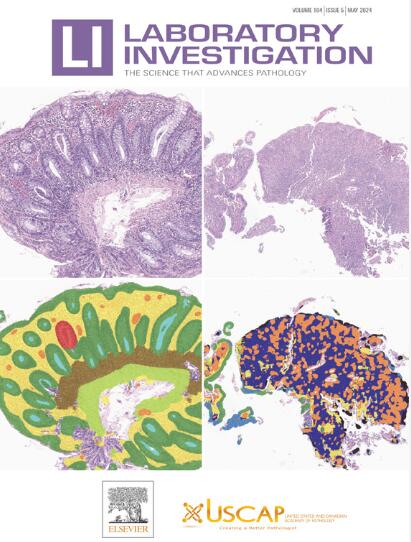空间分析发现CD147是儿童后窝室管膜瘤的新标志物
IF 4.2
2区 医学
Q1 MEDICINE, RESEARCH & EXPERIMENTAL
引用次数: 0
摘要
室管膜瘤(EPN)是儿童中枢神经系统第三常见的恶性肿瘤。癌细胞群的时空异质性会影响EPN克服微环境限制的能力。数据集分析显示,CD147在胶质瘤中的表达增加,其表达与不良生存和更高的突变负担相关。我们对儿童后窝A型EPN (PFA-EPN)中枢神经系统肿瘤微环境进行了空间表型分析。n = 5)和3级(G3;N = 7)。使用多重免疫荧光板检测免疫细胞、小胶质细胞、内皮细胞和肿瘤细胞,对肿瘤进行全面评估。我们根据分级观察到免疫细胞群的显著差异:与G3肿瘤相比,G2肿瘤具有大量T细胞和细胞毒性T细胞浸润的特征。在G3肿瘤中,CD4+和CD8+细胞之间的距离较低,这表明在更具侵袭性的肿瘤中,t细胞群之间的细胞相互作用增加。两种与肿瘤相关的巨噬细胞亚群具有不同的功能表型(CD68+MCP1+和CD68+CD44+),与肿瘤进展相关,先前通过脊髓EPN的单细胞RNA测序分析被鉴定出来。我们证明,与G2 PFA相比,G3的CD68+CD44+群体更高。G3组的CD147+小胶质细胞比G2组更接近CD8+细胞和CD147+肿瘤增殖细胞。在G3肿瘤中,CD4+细胞与CD147+小胶质细胞和CD8+淋巴细胞的距离更远,与CD147+肿瘤增殖细胞的距离更近。我们提供的证据表明,CD147+小胶质细胞可能在PFA-EPN的进展中发挥关键作用,促进CD8+ T细胞的排斥。这些发现强调了PFA-EPN肿瘤微环境的分级相关差异。本文章由计算机程序翻译,如有差异,请以英文原文为准。
Spatial Analysis Identifies CD147 as a Novel Marker of High-Grade Childhood Posterior Fossa Ependymoma
Ependymoma (EPN) is the third most common malignant tumor of the central nervous system in children. The spatial and temporal heterogeneity of cancer cell populations can impact the ability of EPN to overcome microenvironmental constraints. Data set analysis revealed that CD147 expression is increased in glioma, and its expression correlates with detrimental survival and higher mutational burden. We performed spatial phenotyping of tumor microenvironment in childhood posterior fossa type A EPN (PFA-EPN) central nervous system World Health Organization grade 2 (G2; n = 5) and grade 3 (G3; n = 7). Tumors were comprehensively assessed using multiplex immunofluorescence panels to detect immune, microglial, endothelial, and tumor cells. We observed significant differences in immune cell populations according to grading: a high number of T cells and cytotoxic T cell infiltration were features of G2 when compared with G3 cancers. The distance between CD4+ and CD8+ cells was lower in G3 tumors, highlighting an increase in cell interactions between T-cell populations in more aggressive tumors. Two tumor-associated macrophage subsets with distinct functional phenotypes (CD68+MCP1+ and CD68+CD44+), associated with tumor progression, were previously identified by single-cell RNA sequencing analyses in spinal EPN. We demonstrated that the CD68+CD44+ population was higher in G3 compared with G2 PFA. CD147+ microglia cells were closer to CD8+ cells and CD147+ tumor-proliferating cells in G3 than G2 counterparts. In G3 tumors, CD4+ cells were more distant from CD147+ microglial cells and from CD8+ lymphocytes and were closer to CD147+ tumor-proliferating cells. We provided evidence that CD147+ microglial cells could be playing a key role in PFA-EPN progression, promoting CD8+ T cells’ exclusion. These findings highlight grading-related differences in PFA-EPN tumor microenvironment.
求助全文
通过发布文献求助,成功后即可免费获取论文全文。
去求助
来源期刊

Laboratory Investigation
医学-病理学
CiteScore
8.30
自引率
0.00%
发文量
125
审稿时长
2 months
期刊介绍:
Laboratory Investigation is an international journal owned by the United States and Canadian Academy of Pathology. Laboratory Investigation offers prompt publication of high-quality original research in all biomedical disciplines relating to the understanding of human disease and the application of new methods to the diagnosis of disease. Both human and experimental studies are welcome.
 求助内容:
求助内容: 应助结果提醒方式:
应助结果提醒方式:


